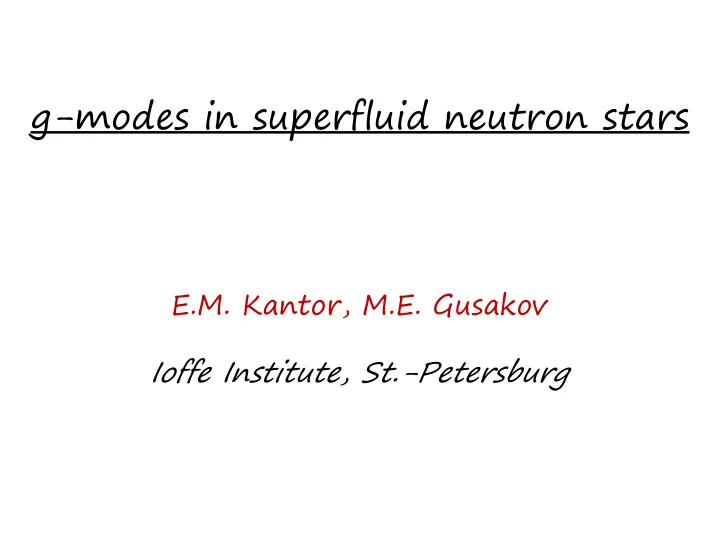

g-modes in superfluid neutron stars E.M. Kantor, M.E. Gusakov Ioffe Institute, St.-Petersburg
Outline • Introduction, g-modes in non-superfluid NS matter • thermal and composition g-modes in superfluid NS matter ( original results ) • Applications and Conclusions
g-modes in non-superfluid npe NS matter
relativistic inertial mass density
relativistic inertial mass density restoring force arises if:
relativistic inertial mass density restoring force arises if: degenerate matter
This condition is always satisfied in beta equilibrated ( ) degenerate npe-matter. Buoyancy is driven by matter composition gradient, no dependence on temperature temperature independent composition g-modes! Reisenegger & Goldreich, ApJ (1992)
g-modes in superfluid npe-matter
In contrast to normal matter, in superfluid matter two independent velocity fields can coexist: velocity of superfluid neutrons velocity of ‘normal’ particles generate => two conditions of hydrostatic equilibrium: the same as in non-superfluid matter additional condition, valid in superfluid matter
=> the imaginary volume element is “ sticked ” to normal matter
=> no restoring force! no g-modes! revealed in a number of numerical calculations: the imaginary volume element is “ sticked ” to normal matter U. Lee A&A (1995) Andersson, Comer MNRAS (2001) Andersson, Comer, Langlois PRD (2002) Prix, Rieutord, A&A (2002)
But account for temperature or/and admixture of additional particles (particularly muons) leads to appearance of g-modes.
the imaginary volume element is “ sticked ” to normal matter
Restoring force arises if: the imaginary volume element is “ sticked ” to normal matter
Restoring force arises if: no muons the imaginary volume element is “ sticked ” to normal matter thermal g-modes (Gusakov & Kantor, PRD, 2013)
Restoring force arises if: the imaginary volume element is “ sticked ” to normal matter degenerate matter composition g-modes (submitted to MNRAS Letters)
We will consider non-rotating star with background metric: in Cowling approximation (no perturbations of ) Consider small non-radial polar perturbations of oscillation equations
Local analysis of the equations describing linear oscillations of superfluid matter (short wave perturbations) Brunt-Vaisala frequency squared Y is a function of superfluid density which depends on temperature temperature dependent composition g-modes do not vanish at T=0
Numerical results Heiselberg & Hjorth-Jensen (1999) parametrization of APR (Akmal, Pandharipande, and Ravenhall, 1998) equation of state (EOS) in the core. 11.0 km 12.1 km 10 .7 km core-crust interface threshold
Brunt-Vaisala frequency of superfluid matter Brunt-Vaisala frequency of non-superfluid matter
Temperature dependence of Brunt-Vaisala frequency
Eigenfrequencies of stellar oscillations Critical temperature profiles
Eigenfrequencies of stellar oscillations Critical temperature profiles Two layers: inner superfluid and outer non- superfluid
no superfluid neutrons in the star and the star oscillates as a non- superfluid one => normal g-modes low temperature asymptote for superfluid g-modes, no temperature dependence
Conclusions • A peculiar class of temperature dependent composition g- modes is shown to exist in superfluid matter of NS cores. • Their frequencies appear to be rather high, of the order of the spin frequencies of the most rapidly rotating neutron stars. • This means that oscillation spectra of rotating neutron star will be significantly affected by these g-modes. • Analogous composition superfluid g-modes should exist in laboratory superfluids (one superfluid, say He II, + two non- superfluid species). • Probably are already observed as the coherent frequency 249 Hz identified in the light curves of a millisecond X-ray pulsar XTE J1751-305?
Recommend
More recommend